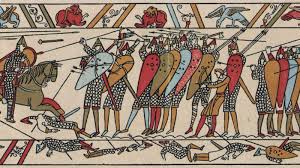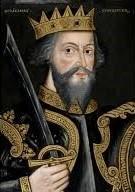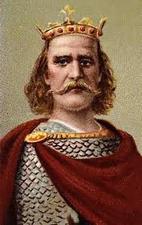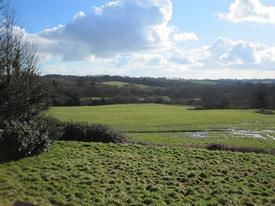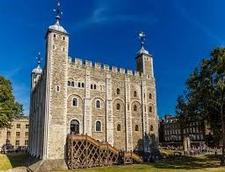In early 1066, England witnessed a terrifying sight. A burning object was seen flying through the sky, searing fear into the hearts of the people below. Hundreds of years later, the English scientist Edmond Halley would establish that the object had been a comet, Halley’s comet, that orbits the Earth and is visible to the human eye every 75 years or so. But Halley’s ancestors had another explanation for the phenomenon. There was no doubt in their minds that it was a sign of God’s displeasure, an omen of a dreadful future.
Months earlier, an Anglo-Saxon lord named Harold Godwinson had declared himself King of England after the previous King, Edward the Confessor, died without an heir. As the most powerful member of the English nobility Godwinson had assumed that he was the natural replacement, but his confident ascendency to power could not paper over the huge questions about his legitimacy. In the north, the King of Norway, one of the last great Viking warlords, claimed that he was the rightful King of England. But to the south lay an even graver threat. Across the channel from the southern English coast lay the French Duchy of Normandy and its Duke, William, who claimed that he had been promised the English throne by Godwinson himself. In William, Godwinson had a ruthless enemy who was desperately insecure and would go to any lengths to prove his own legitimacy.
The comet which appeared in early 1066 is explainable by modern science but it is in this context that the panic it caused must be understood. This was a population unsure of the legitimacy of their King and bracing itself for foreign invasion. Indeed, the panic it caused turned out to be entirely justified. Before the year was over, the Anglo-Saxon England that had existed would be gone, its people conquered, and its ruling class replaced by a French aristocracy.
Why did William claim the English throne?
William was not a secure man. Born out of wedlock in 1028 to Duke Robert of Normandy and a tanner’s daughter known as Arlette, he had been raised in perpetual fear of his life and even witnessed the murder of his guard by his bedside when he was a young boy. Powerful figures had targeted him because he was Robert’s only son and was named the heir to the Dukedom on Robert’s death in 1035. William survived childhood to eventually take full control of the Duchy but still found himself constantly having to fend off challenges to his authority and was hurt by his moniker, ‘William the Bastard.’ He was a man who did not feel safe in his position and felt he needed to secure more land for himself to sure up his rule.
William of Normandy was an insecure leader
Harold Godwinson took the English throne for himself
England was always a kingdom he had his eye on. He was cousins with the English King Edward and claimed that Edward had promised to name him his heir when he travelled to meet him in 1051. William’s claim gained even more traction in 1064 when Harold Godwinson ended up shipwrecked on the Norman coast. William offered him hospitality and safe passage back to England on the condition that Godwinson would support his claim to the English throne when Edward died. Godwinson agreed, and William was certain that he would be the next King of England.
It is hard to imagine his anger when word reached him in January of 1066 that Edward had died and Harold Godwinson had taken the throne for himself. William immediately denounced Godwinson as a treacherous usurper and made moves to gather support for a full-scale invasion of England. The Normans themselves never needed much encouragement to go to war. They were the descendants of Viking marauders who had been gifted the land in northern France by the French King – the name ‘Normandy’ is derived from the fact that it was the land of the Northmen. Although they had adopted some French customs, converting to Christianity and speaking a dialect of French, the Normans had not lost the thirst for war that their Scandinavian ancestors were notorious for and William himself was a descendant of the famed Viking warlord Rollo. As his forces gathered for the invasion William secured backing from the Pope, and by July the Norman invasion force of around 7,000 men and 600 ships was stationed on the coast, waiting for a favourable wind to carry them across the channel.
But the favourable wind would not come. William waited for a few days, before becoming impatient and deciding to set sail anyway. The attempted crossing was a disaster, and William’s fleet was scattered across the French coast. The fleet re-grouped and William was forced to wait, prowling the Norman beaches and glaring across the channel where his rightful kingdom lay just over the horizon.
Harold faces threats from the North
Across the channel Harold Godwinson was with his Anglo-Saxon forces waiting for the Norman invasion he knew was coming. It would have been incredibly tense, scanning the horizon every day for any signs of the invading fleet, but he must have started to become increasingly more relaxed as the summer drew to a close. It was highly unlikely that William would attempt to cross the channel in the winter months and risk being caught by one of the fierce winter storms which frequented the seas around northern Europe, and towards the end of September Harold’s main concern was that every day his army remained stationed on the south coast was another day he had to pay his men and another day they were away from the harvest in their home shires.
Harold was content that the threat may have subsided for the year, but word started to reach him of trouble brewing in the north. This was a bitter blow for Harold, made even more so by the fact that it was a familiar face who was sewing the trouble – it was his younger brother, Tostig.
Tostig had been Earl of Northumbria until 1065 when his tyrannical ways inspired a popular uprising and the people of Northumbria petitioned King Edward to declare Tostig an outlaw. Edward sent Harold to listen to the people’s grievances, and there were many; so many that Harold was forced to disavow his own brother and side with the people. Tostig was duly declared an outlaw and exiled from the kingdom, and he had spent every day since then plotting revenge on his brother. Through 1066 Tostig visited various rulers, including William, and petitioned them to invade England. Having spent most of the summer in Scotland trying unsuccessfully to persuade King Malcolm III to invade, he travelled to Norway to meet King Harald Hardrada. In Hardrada, which literally translates to ‘hard ruler’, Tostig found an ally who was keen on the idea of invading England.
Tostig, Hardrada and 11,000 Vikings reached the Tyne river in September and easily swept aside a paltry defence mustered by Morcar, the new Earl of Northumbria. They set up camp at the River Derwent just outside York and ordered the local people to send them hostages and supplies, confident that the main Anglo-Saxon army would still be hundreds of miles south. But unbelievably, Harold had marched his army 185 miles in just four days and arrived in York in time to hear of the Viking demands of the local people.
On the morning of 25th September, the Norse invaders were horrified when instead of hostages and supplies they were confronted with the entire English army. Such was their surprise that some of their troops were stranded on the other side of the river from the bulk of the army, and many of the warriors were basking shirtless in the late-summer heat, having left their chain-mail armour on their ships. Harold swooped down the hill and dealt with the unfortunate Vikings who had been caught on the wrong side of the river, before making an offer to his brother; Tostig could have his Earldom back if he laid down his arms. But Tostig was unrepentant. He demanded that his ally Hardrada be given land as well, to which Harold is said to have replied that he ‘would offer Harald seven foot of good English soil, or as much as he needed as he was taller than other men.’ Thus began the Battle of Stamford Bridge. Harold ordered his Anglo-Saxon army to cross the bridge and face their Viking foe but according to chroniclers they were held up by a huge Norseman, who stood on the narrow crossing and held the entire English force back on his own. It was only after an Englishman used a barge to get under the bridge and thrust a spear upwards that this fearsome warrior was vanquished, and the English army poured across and broke the shield wall that the Vikings had formed. The invading force, including Tostig and Hardrada, was wiped out and of the 300 ships that had left Norway, only 40 were needed to carry the survivors back to their homeland.
William finally arrives in England
While the English army were resting after their victory at Stamford Bridge, the winds on the Norman coast finally turned in William’s favour. The Normans wasted no time, and landed at Pevensey on 28th September, just three days after Harold’s victory in the north. William was relieved, if a little perplexed, to find the south coast of England undefended. Once his men and horses were ready, he went in search of the Anglo-Saxon army and learnt of the reason for their absence. He would have been worried when he learnt of the Viking invasion – the last thing he needed was another enemy to compete with – but was no doubt elated when he got word of what had transpired at Stamford Bridge. Not only had the Vikings been defeated but the English army would be exhausted. Intent on fighting the English while they were dead on their feet, William set about terrorising the local area in order to force Harold’s hand. He would not allow the English to rest; they would have to protect their people and march to meet him.
Harold led his fatigued army on the long march south, picking up inexperienced new recruits along the way. He learnt of William’s whereabouts, near Hastings, and by the evening of 13th October the two armies had spotted each other. The next morning, 14th October 1066, the Battle of Hastings began.
The Anglo-Saxon army had one obvious disadvantage; they had marched over 350 miles in the previous three weeks and had only just vanquished an 11,000-strong Viking force, while the Norman army were well rested. However, aside from that they seemed to be in the stronger position. The armies were roughly equal in number, but the Anglo-Saxons had positioned themselves on top of a ridge, nullifying the calvary charges which formed the backbone of Norman military strategy. Indeed, the first few Norman charges of cavalry and infantry were easily repelled by the English and rumours started to spread that William himself had been killed. William rode among his soldiers to show that he was very much still alive, although the fact that he did this on his fourth horse of the day shows where the confusion had come from – three of his horses had been killed under him. Still, the battle appeared to be going well for the English, and the Normans showed no sign of being able to break the defensive ranks on top of the ridge.
The battlefield near Hastings
It was after a few hours of the battle that the Normans are said to have either employed a brilliant strategy or become the ultimate beneficiaries of their own soldiers fleeing. It is not known whether there was an order given among the Norman ranks to tactically retreat from the ridge, or whether they were genuinely fleeing the field of battle, but in any case it gave the Anglo-Saxons a false sense that the battle was won. Confident of victory and sensing an opportunity to rout the invading force, the English started to break ranks and charge from the ridge. This misreading of the situation signalled the end of Anglo-Saxon England. Finally fighting on an even field and with the enemy ranks broken, the Normans used their cavalry to brutal effect, mowing down scores of English soldiers while yet more were mown down by Norman archers. The popular legend asserts that Harold Godwinson himself was killed by an arrow to the eye, but there is no way of knowing how he met his end – the only certainty is that he died on that battlefield along with two of his other brothers, and along with Anglo-Saxon England. With their King dead and the battle lost, the surviving English soldiers began to flee. By the end of the day, William could retire from the battlefield knowing that he had achieved his long-held goal of becoming King of England. No longer would people refer to him as ‘the bastard’. He would now be known as William the Conqueror.
William sent his army ahead to march on London, where the Anglo-Saxon authorities were quick to bend the knee and accept him as their new King. So it was that on Christmas Day 1066, William was crowned in Westminster Abbey. But even this formality was not without incident. When the crown was placed on William’s head, there was such a cheer from inside the abbey that the Norman guards posted outside thought there was an assault underway. Rather than attempt to enter the abbey to protect their King, they proceeded to set fire to every building nearby. From this moment the new French rulers, who thus far had been treated with suspicion but general tolerance by the English population, were considered treacherous and tyrannical. It is no accident that William ordered the construction of the Tower of London almost immediately after his coronation in order to establish a firm and intimidating grip on the city, in case the people got any ideas about rebellion.
The keep of the Tower of London, built on the orders of William the Conqueror
It would take William another six years to complete his conquest of England. Over the course of these six years he remorselessly crushed sporadic rebellions in the midlands and north of England, where Anglo-Saxon nobles had allied with the Danes, who still had a large influence in those parts of the country. In order to starve his enemies of food and other supplies William engaged in a systemic devastation of the countryside and farmland in Mercia and Northumbria, costing many lives and cementing his place in English eyes as a tyrant. By the 1070s he had totally got rid of the existing Anglo-Saxon nobility and replaced them with French and Flemish nobles, complete with intimidating stone castles dotted around the Kingdom and small forces to maintain order.
The legacy of the Norman conquest stretches far beyond the 11th century. For starters, it led to the modern English language. William was keen to learn the language of his new subjects but struggled to get to grips with old English, which was rooted in Germanic languages rather than Latin. In the end, French became the language of the English royal court and would remain so until the 15th century. Gradually, French and old English merged to form the modern English language we speak today; while still a Germanic language, it is generally thought that around 10,000 words in modern English have their roots in French.
William’s reign also saw the first attempt at a national census. Responding to an economic slump in the 1080s, William ordered a census of land and people to be taken across the kingdom so his government could assess the actual and potential economic wealth of the country. This census took the form of the Doomsday Book in 1086, after which English governments always had an idea of the population of the kingdom.
In truth it is impossible to measure the impact the Norman invasion of 1066 had on England. It was in many ways the first step on the road to England becoming the country it is today, with its modern language, culture and legal framework. It is a popular saying in England that the nation has not been invaded since 1066, and while this is not strictly true it is certain that there is no invading force which has come close to altering the country in the way that the Normans did in 1066. The French invaders may have only physically replaced the ruling class in England, and most English people today remain descendants of the Anglo-Saxons, but the invasion of 1066 ensured that they live in an entirely alien country to the one their ancestors fought to protect.
Acknowledgements
The Ministry of History is not an academic source. Our pieces are written by writers who have been studying history for years and are well versed in, and influenced by, countless other writers and works. For this article specifically our sources have included:
'The Battle of Hastings', article by Ellen Castelow, published by historic-uk.com
'What happened at the Battle of Hastings?', article published by english-heritage.org.uk
Images
Image one - skynews.com
Image two - historyonthenet.com
Image three - bbc.co.uk
Image four - trickygirl.wordpress.com
Image five - britannica.com

